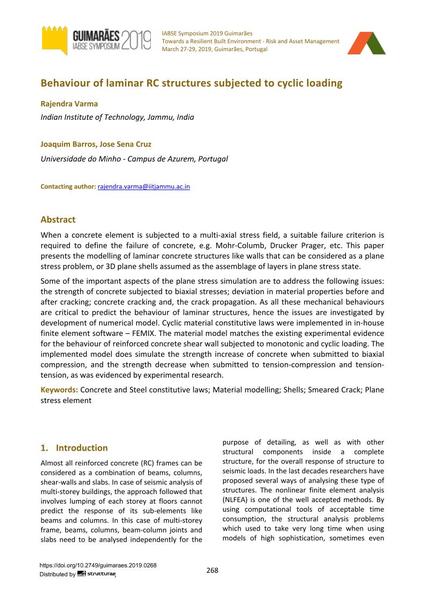Behaviour of laminar RC structures subjected to cyclic loading

|
|
|||||||||||
Bibliografische Angaben
| Autor(en): |
Rajendra Varma
(Indian Institute of Technology, Jammu, India)
Joaquim A. O. Barros (Universidade do Minho - Campus de Azurem, Portugal) José Sena-Cruz |
||||
|---|---|---|---|---|---|
| Medium: | Tagungsbeitrag | ||||
| Sprache(n): | Englisch | ||||
| Tagung: | IABSE Symposium: Towards a Resilient Built Environment Risk and Asset Management, Guimarães, Portugal, 27-29 March 2019 | ||||
| Veröffentlicht in: | IABSE Symposium Guimarães 2019 | ||||
|
|||||
| Seite(n): | 268-275 | ||||
| Anzahl der Seiten (im PDF): | 8 | ||||
| DOI: | 10.2749/guimaraes.2019.0268 | ||||
| Abstrakt: |
When a concrete element is subjected to a multi-axial stress field, a suitable failure criterion is required to define the failure of concrete, e.g. Mohr-Columb, Drucker Prager, etc. This paper presents the modelling of laminar concrete structures like walls that can be considered as a plane stress problem, or 3D plane shells assumed as the assemblage of layers in plane stress state. Some of the important aspects of the plane stress simulation are to address the following issues: the strength of concrete subjected to biaxial stresses; deviation in material properties before and after cracking; concrete cracking and, the crack propagation. As all these mechanical behaviours are critical to predict the behaviour of laminar structures, hence the issues are investigated by development of numerical model. Cyclic material constitutive laws were implemented in in-house finite element software – FEMIX. The material model matches the existing experimental evidence for the behaviour of reinforced concrete shear wall subjected to monotonic and cyclic loading. The implemented model does simulate the strength increase of concrete when submitted to biaxial compression, and the strength decrease when submitted to tension-compression and tension- tension, as was evidenced by experimental research. |
||||
| Stichwörter: |
Schalen
|
||||
